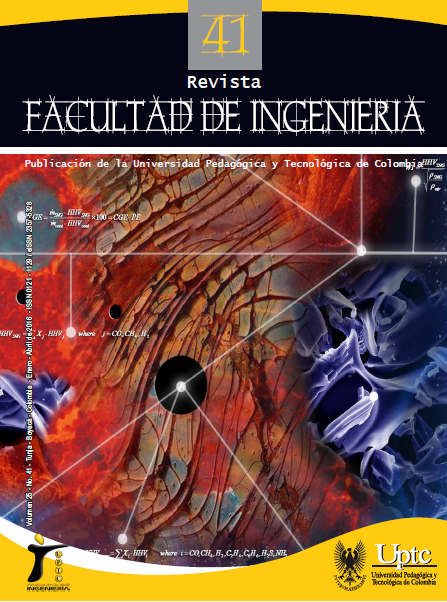A Regulations’ Survey for the Wireless Telecommunications Deployment in Colombia

Abstract
This paper describes the current wireless telecommunications infrastructure deployment regulations in Colombia. It also refers to the possible effects that this infrastructure could cause to the country`s health and environment. similarly, the results obtained show a comparison between the Argentina’s current regulations, one of the most relevant researchescarried out and the Colombian case. finally, some recommendations are proposed that can be considered in the project of regulations applicable in Colombia for the ensuring purpose that the non-ionizing radiation generated by wireless communications systems do not have effects on health and the environment.
Keywords
regulation of telecommunications, Non-Ionizing Radiation (NIR), communications and health, visual pollution telecommunications, infrastructure deployment
References
- Colombia. Ministerio de Comunicaciones, Ministerio de Protección Social. Decreto 195 de 2005 “por el cual se adopta límites de exposición de las personas a campos electromagnéticos, se adecuan procedimientos para la instalación de estaciones radioeléctricas y se dictan otras disposiciones”. Enero 31, 2005.
- J. P. Hernández, D. P. Morales. Código de Buenas Prácticas para el despliegue de infraestructura de redes de comunicaciones. Comisión de Regulación de Comunicaciones, Agencia Nacional del Espectro. 2012.
- C. Baliatsas, I. Van Kamp, M. Hooiveld, J. Yzermans, E. Lebret. “Comparing non-specific physical symptoms in environmentally sensitive patients: prevalence, duration, functional status and illness behavior”. J. Psychosom Res, 76(5): 405-413. 2014. DOI: http://dx.doi.org/10.1016/j.jpsychores.2014.02.008. DOI: https://doi.org/10.1016/j.jpsychores.2014.02.008
- International Agency for Research On Cancer. IARC. Classifies Radiofrequency Electromagnetic Fields as Possibly Carcinogenic to Humans. 2011. Recuperado de http://www.iarc.fr/en/media-centre/pr/2011/pdfs/pr208_E.pdf.
- D. Krewski, C. V. Byus, B. W. Glickman, W. G. Lotz, R. Mandeville, M. L. Mcbride, F. S. Prato, and D. F. Weaver. “Potential Health Risks of Radiofrequency Fields from Wireless Telecommunication Devices”. Journal of Toxicology and Environmental Health - Part B: Critical Reviews 4, no. 1: 1-143. 2001. DOI: http://dx.doi.org/10.1080/109374001459458. DOI: https://doi.org/10.1080/109374001459458
- G. Gandhi, G. Kaur, U. Nisar. “A cross-sectional case control study on genetic damage, in individuals residing in the vicinity of a mobile phone base station”. Electromagnetic Biology and Medicine. 2014. DOI: https://doi.org/10.3109/15368378.2014.933349
- O. J. Tibasosa Bernal. Estudio de impacto ambiental de la contaminación visual causada por las estaciones de telefonía celular en Bogotá D.C. Tesis de grado. Universidad Militar Nueva Granada, Bogotá D.C. Colombia. 2013.
- J. F. Morais, and G. L. Siqueira. “Wireless Technologies Environmental Impacts”. In SBMO/IEEE MTT-S International Microwave and Optoelectronics Conference Proceedings, 523-527. 2009. DOI: http://dx.doi.org/10.1109/imoc.2009.5427529. DOI: https://doi.org/10.1109/IMOC.2009.5427529
- M.Z. Netzer. “Electrophobia and Misperception of Non-Ionizing Radiation Hazards. Electromagnetic Compatibility”, 2003. EMC ‘03. IEEE International Symposium on Electromagnetic Compatibility (EMC), 2: 724-727, 2003. DOI: https://doi.org/10.1109/ICSMC2.2003.1429007
- M. Dolan, and J. Rowley. “The Precautionary Principle in the Context of Mobile Phone and Base Station Radiofrequency Exposures”. Environmental Health Perspectives, 117 (9): 1329-1332, 2009. DOI: http://dx.doi.org/10.1289/ehp.0900727. DOI: https://doi.org/10.1289/ehp.0900727
- Agencia Nacional del Espectro. Sistema de Medición Continua. Recuperado de http://servidorweb2.sitimapa.com/ane/#, 2014.
- University Hospital Rwth Aachen. EMF-portal. 2012. Recuperado de http://www.emf-portal.de/?l=e.
- S. Lagorio, M. Röösli M. “Mobile phone use and risk of intracranial tumors: A consistency analysis”. Bioelectromagnetics, 35 (2): 79-90, 2014. DOI: http://dx.doi.org/10.1002/bem.21829. DOI: https://doi.org/10.1002/bem.21829
- V. S. Benson, K. Pirie, J. Schüz, G. K. Reeves, V. Beral, J. Green. “Mobile phone use and risk of brain neoplasms and other cancers: prospective study”. Revista J Epidemiol, 42(3): 792-802, 2013. DOI: http://dx.doi.org/10.1093/ije/dyt072. DOI: https://doi.org/10.1093/ije/dyt072
- J. Rowley. Redes Móviles: Niveles de Exposición y Política de despliegue. GSMA, 2007.
- Organización Mundial de la Salud. Nota Descriptiva 304. 2006. Recuperado de http://www.who.int/peh-emf/publications/facts/fs304/es/
- ICNIRP. Aproximación general para la protección contra la radiación no-ionizante. 2007. Recuperado de http://www.icnirp.de/documents/philosophyesp.pdf.
- H. Carril. Emisiones Electromagnéticas No Ionizantes y los despliegues de Redes Inalámbricas –Una Problemática Latinoamericana–. UIT, 2013.
- Corte Constitucional de Colombia. Sentencia T 360 de 2010 “Por la cual se resuelve acción de Tutela y se exhorta al ministerio TIC y a la Comisión de Regulación de Comunicaciones”. 2010.
- Corte Constitucional de Colombia. Sentencia T 1077 de 2012 “Por la cual se ordena a Telefónica Telecom S.A. E.S.P. desmontar la estación base localizada en el inmueble ubicado en la calle 5ª con carrera 6ª - Esquina, en Fresno, Tolima”. 2012.
- ARBO S.A.S. Mimetizaciones. Recuperado de http://www.arbo-sas.com/main/mimetizaciones.html. 2015.
- M. de los A. Saenz. “Evaluación de la disponibilidad de la señal en El Albarracín”. Revista Electrónica del Patrimonio Histórico. 2011. Recuperado de http://www.revistadepatrimonio.es/revistas/numero9/intervencion/estudios/articulo5.php#popup12.
- Colombia. Constitución Política de 1991. Bogotá: Legis. 2014.
- Colombia. Congreso de la República. Ley 1341 de 2009, por la cual se definen principios y conceptos sobre la sociedad de la información y la organización de las tecnologías de la información y las comunicaciones -TIC-, se crea la Agencia Nacional de Espectro y se dictan otras disposiciones. Bogotá, julio 30. 2014.
- Colombia. Ministerio de Comunicaciones. Resolución 1495 de 2005, “Por la cual se reglamenta el Decreto 195 de 2005”. Julio 29 de 2005.
- Colombia. Congreso de la República. Ley 99 de 1993, “Por la cual se crea el Ministerio del Medio Ambiente, se reordena el Sector Público encargado de la gestión y conservación del medio ambiente y los recursos naturales renovables, se organiza el Sistema Nacional Ambiental, SINA, y se dictan otras disposiciones”. Bogotá, diciembre 22 de 1993.
- Colombia. Ministerio de Ambiente y Desarrollo Territorial. Decreto 2820 de 2010, “Por el cual se reglamenta el Título VIII de la Ley 99 de 1993 sobre licencias ambientales”. Bogotá. Agosto 5 de 2010.
- Concejo Municipal de Montería. Acuerdo 016 del 17 de noviembre de 2011 “Por el cual se expide el Plan de Desarrollo 2011-2015”. 2011.
- Revista Dinero. Operadores culpan a municipios por mala señal. 2013. Recuperado de http://www.dinero.com/empresas/articulo/operadores-culpan-municipios-malasenal/175402.
- V. D. Frizzera. Radiaciones No Ionizantes – Comisión Nacional de Comunicaciones de Argentina–. Recuperado de http://www.cnc.gob.ar/multimedia/noticias/archivos/201408/archivo_20140821033028_6863.pdf. 2007.